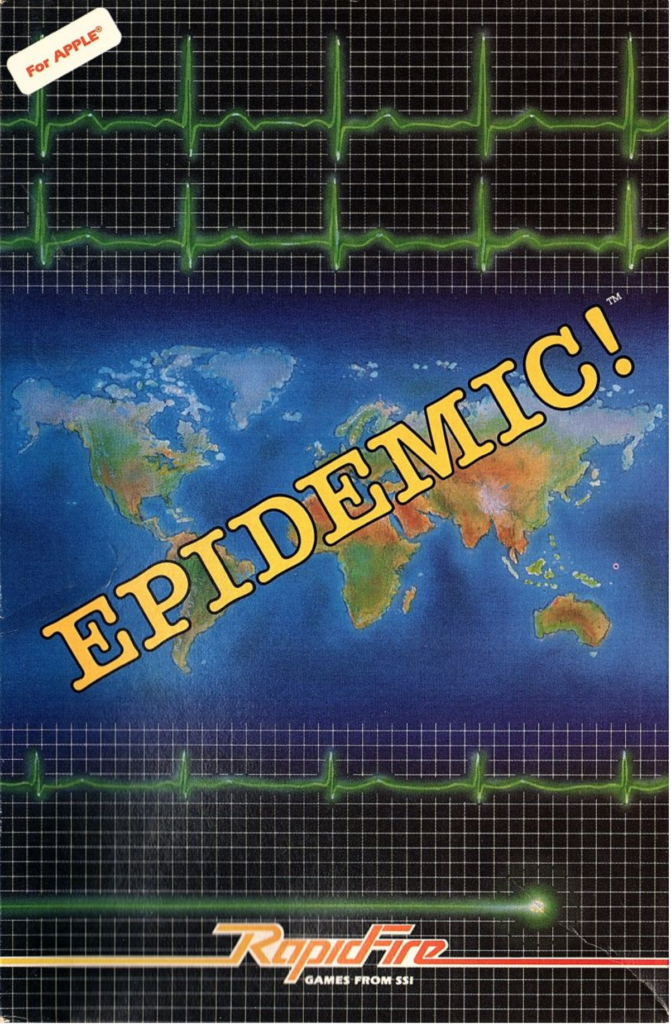
Professor Narwhal – what is your strategy against the deadly alien pathogen which already contaminated Australia, the Middle East and, apparently, Greenland ?
Same way I fought every other alien scum : missiles and nukes.
Nukes ? Really ? What about vaccin…
Do you think I would be playing this game if it wasn’t for the missiles ?
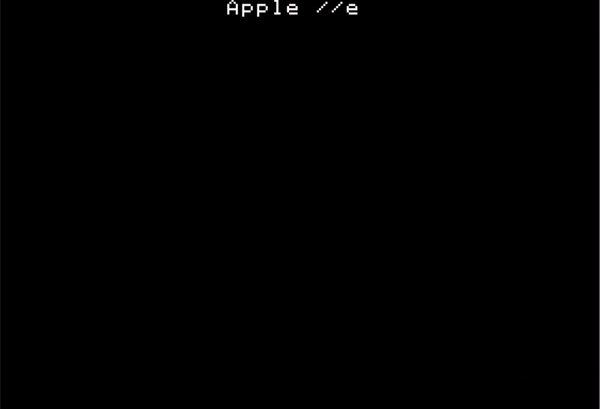
Steven Faber’s Epidemic! is one of those rare early games that SSI called General simulations in its catalogue that are neither about sports nor about war. In late 1982 this category only included two other games : Dan (Danielle) Bunten’s Cartels & Cutthroat$, and Nelson Hernandez’s President Elect. Cartels & Cuththroat$ was about making your company grow, and President Elect about winning the US election. Now the stakes are even higher : it is about saving humankind from a terrible virus !
In Epidemic!, the killer-disease is not some boring epizootic virus calling into question humankind’s hubris as master and possessor of nature yada yada yada. No, it comes from SPAAACE, riding meteorites, and according to the manual it already wiped out the dinosaurs 65 million years ago. Beat THAT, Covid !
The player is the leader of “an international task force marshalling the world resource and medical technology” who must either stop the epidemic or at least have kept the casualties as limited as possible when the game ends (which could be anywhere between 15 and 30 days depending on the difficulty of the game). The player is given absolute leeway – including the power to blow-up a whole continent with nukes for the greater good – no questions are asked, or if they are, it is after the end screen.
At the start of my game, I am informed that the first disease outbreaks happened in regions #5, #10 and #14, i.e. Greenland, the Middle East and Australia :
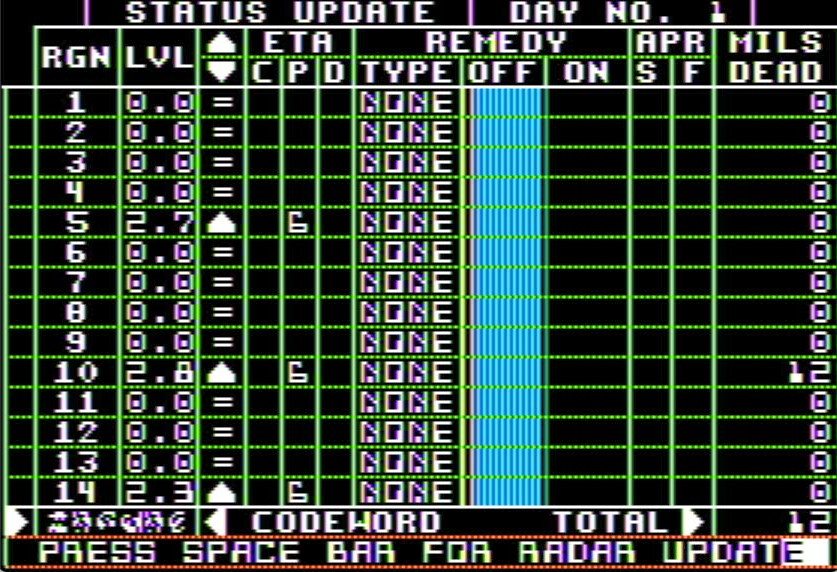
The “epidemic level” in a region ranges from 1 to 5 (0 if disease-free), but there are four thresholds that matter :
- From 1.0 to 1.9, the disease is “in stasis”, which means it kills some people every turn, but does not spread further geographically. Disease intensity converges toward 1.0,
- From 2.0 to 2.9, the disease is “mild”. It kills people, grows in intensity by 15% every turn, but cannot spread geographically,
- From 3.0 to 4.9, the disease is serious (up to 4) or critical (up to 4.9). It still grows at 15% per turn, kills a lot of people and spreads from one region to another,
- At 5.0 (which is a cap), or if a virus has remained too long between 2.0 and 4.9, the disease becomes pneumonic. Normal remedies don’t work anymore, and the virus will wipe-out the entire population of an area in 5 turns.
In my case, all the contaminated regions start at the “mild” level, which probably means that politicians everywhere else just shrug, claim that the Australian/Arabic flu will never reach their country, in any case their superior healthcare system is totally going to handle the few cases that may reach them, and then they resume talking about whatever is their local hot issue.

The player then receives radar reports of all the meteorites flying around :
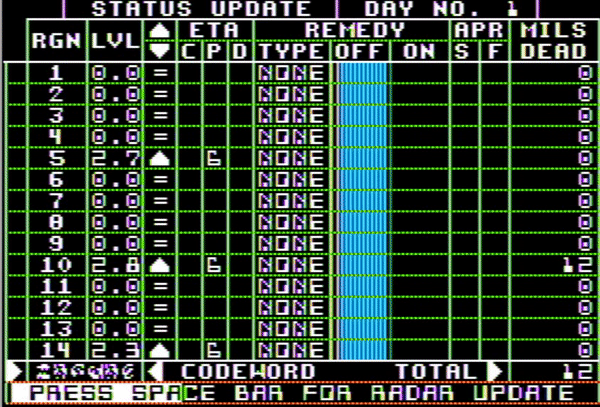
Only 3 meteorites reached surface level and every time they sank in the Ocean. I sure hope that virus cannot contaminate fish, but just in case, we had the collective foresight to overfish. Phew !
I finally get to do something. Sadly, probably drowned in typical multilateral red tape, the player can only take 3 actions by turn, between :
- Applying a remedy to a region,
- Sending a missile towards one of the meteorites,
- Nuking a country,
All regions are not equal : some are isolated (contamination in Australia can only spread to Eastern Asia), some are crossroads (eg the Soviet Union, of course). Some are highly populated (South-East Asia : 1.5 billion inhabitants, so 1/3 of the global population), some are not populated at all (Greenland : 0 million, so its level of contamination is only really relevant as a “bridge” between Canada and Northern Europe).
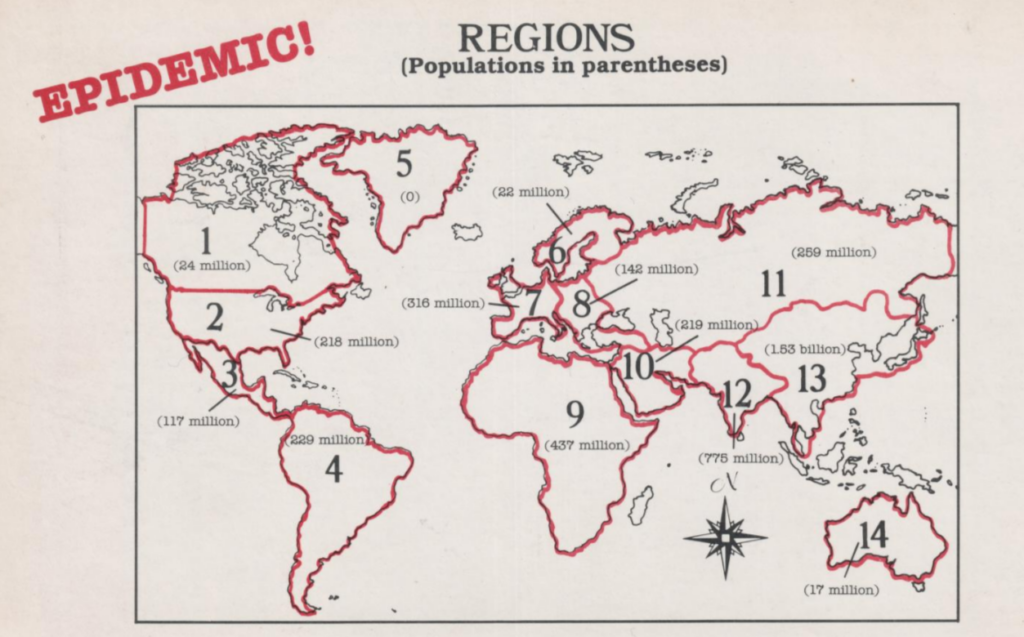
The player starts at 1 000 points and loses points depending on the casualties. This means I can afford the killer-disease rampaging in Greenland and even in Australia (17 million inhabitants), but the Middle East is a bit more worrisome with its 219 million inhabitants.
There are 8 possible remedies. The most powerful in the short term is the first remedy : the “Interferon“. While super-efficient (-25% disease level), its effect ends after one turn, so it needs to be repeated ; with only 3 actions a turn it is not always a wise solution. On the other end of the spectrum, the 8th remedy (“gene splicing”) is an almost guaranteed cure after 5 days… but it takes 4 days to start to take effect, an interval of time during which the disease can kill, spread to other regions and even reach “pneumonic” status (in which case no normal remedy, including the gene splicing, has any effect).
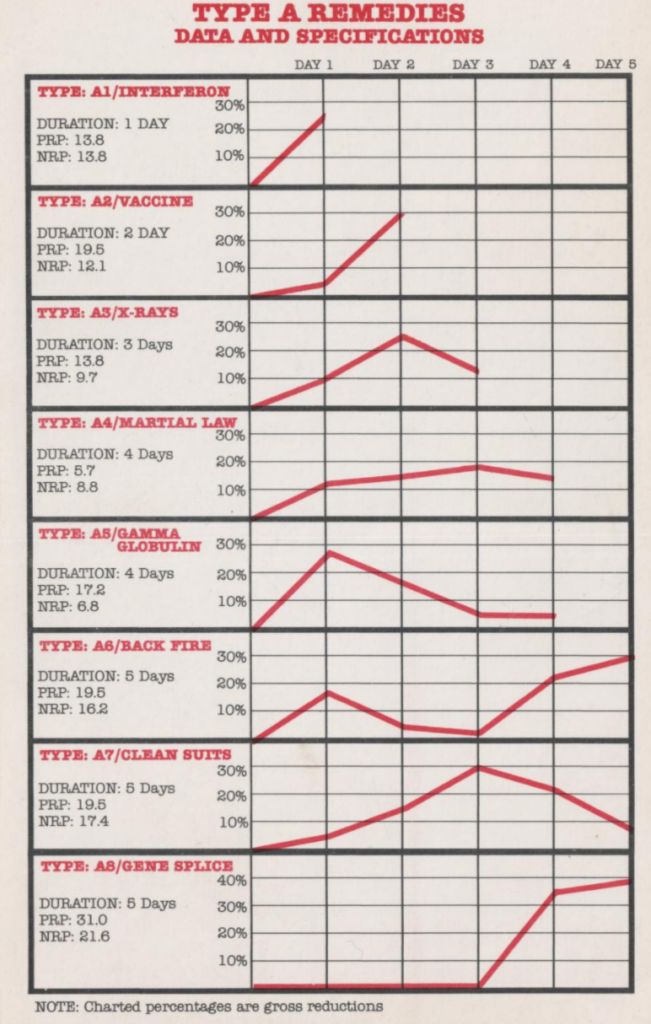
My strategy is to prevent at any cost the disease from spreading to Southern or Eastern Asia. For Greenland, I am under no urgency, so I decide to apply Gene Splicing to the 50 000 or so inhabitants. This solution will not be acceptable for Australia : the delay before the Gene Splicing has any effect will allow the disease level to be severe or even critical, and in this case it is likely the disease will disseminate to Eastern Asia. There, I choose remedy #6 (“Backfire“) to keep the disease under control until the “reduction peak” of turn #4 and #5 triggers.

As for the Middle East, due to its population, every day that passes has a significant impact on the body count, and I can’t let the disease spread to other regions from there either, so I am going with Interferon every turn.
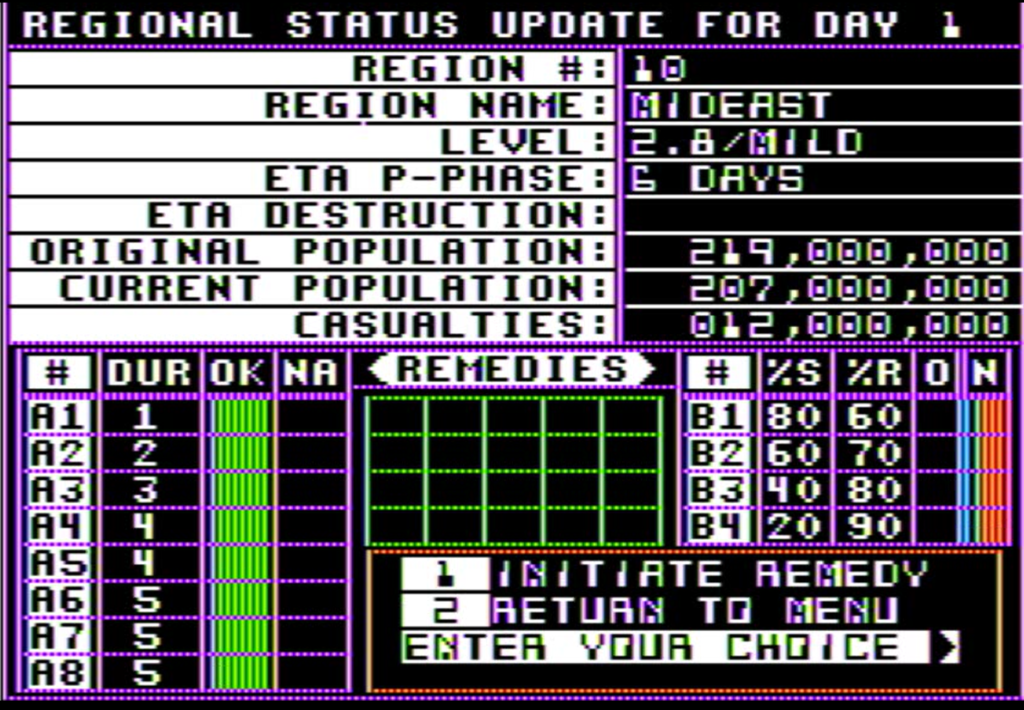
Once I have taken my 3 actions, next turn automatically starts. This time, I can explain the Microsoft Access screen a bit more :
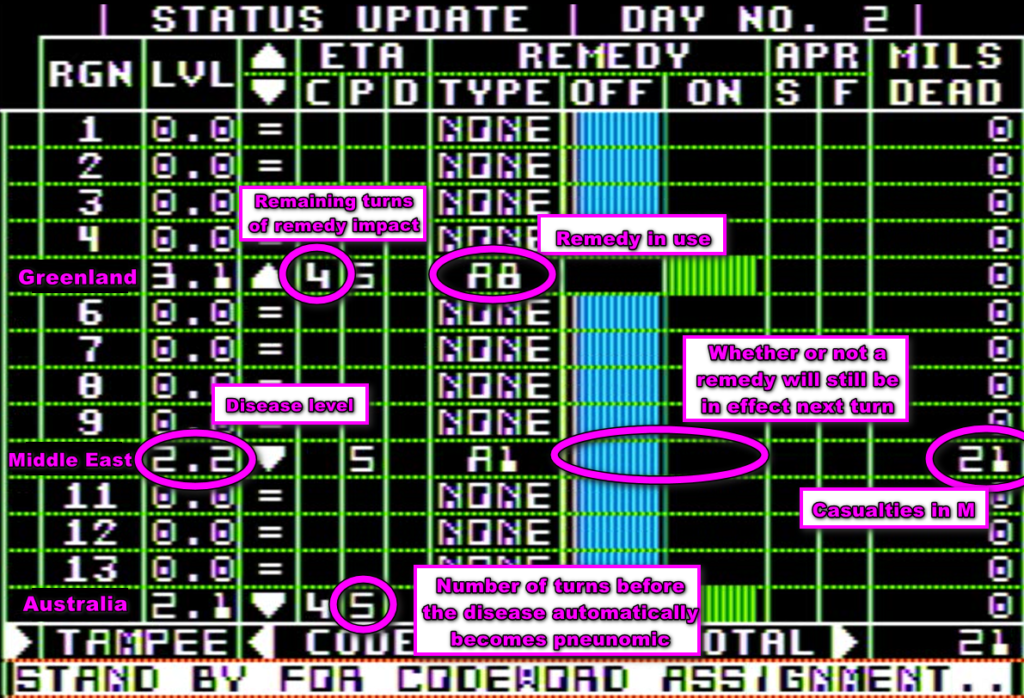
So far, everything is going as predicted. Better yet – none of the meteorites crashes on land this turn either, though Greenland manages to spread the flu to Scandinavia.
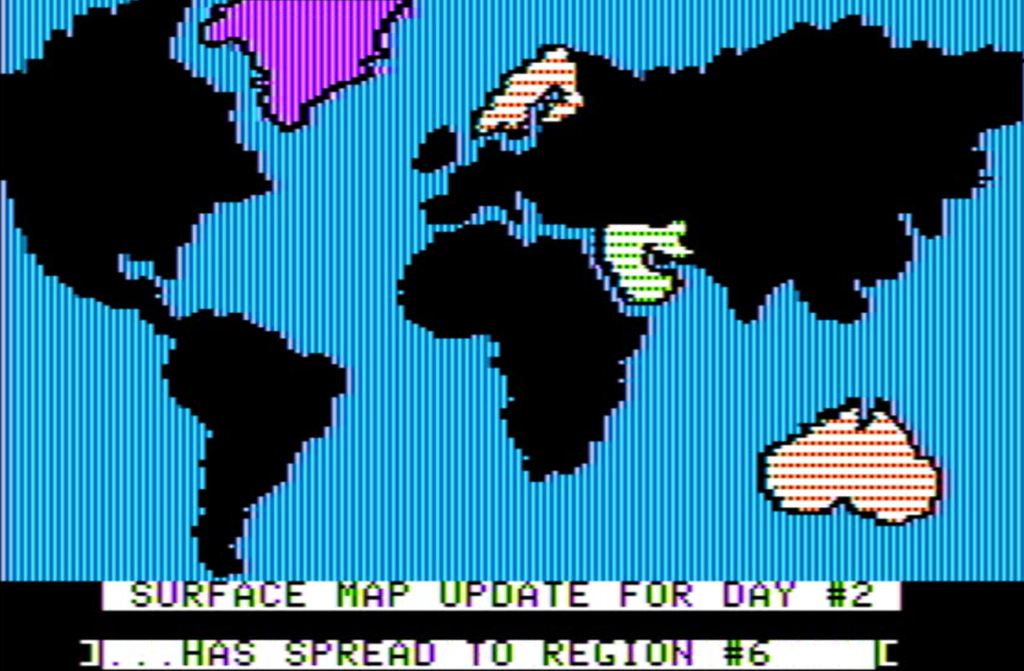
Next turn, I allocate more Interferon to the Middle East, some Vaccines (remedy #2) to Scandinavia so I don’t have to take care of them next turn, and find myself with one extra action, which I can use for my favourite : missiles ! Checking the different meteorites, none is at risk of hitting the landmass tomorrow, but one may hit Latin America in a couple of days.
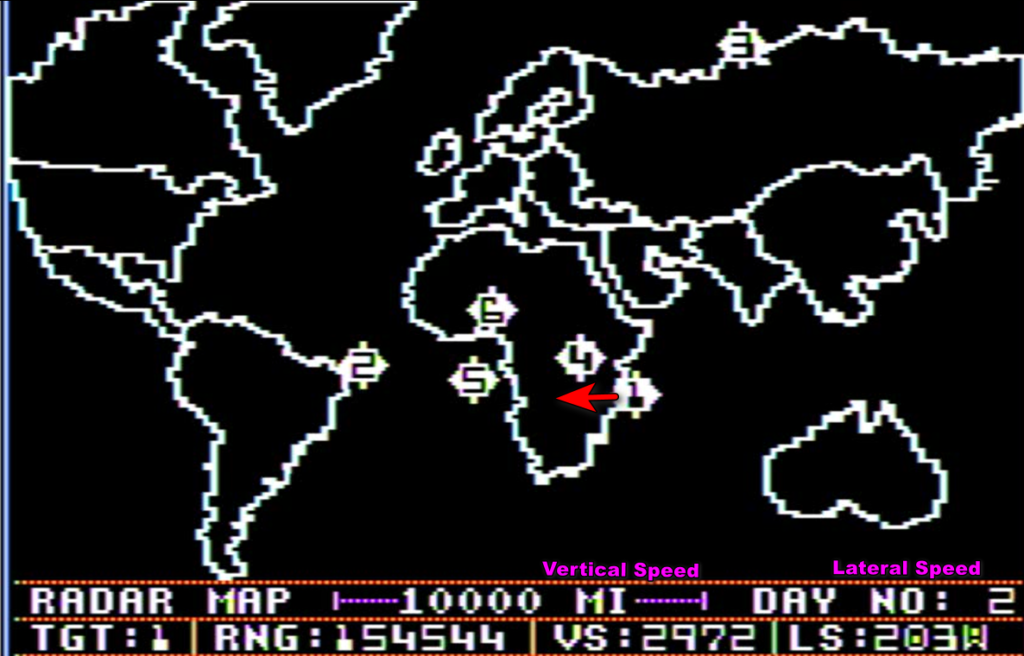
Sadly, hitting targets above 10 000 miles of altitude is very difficult, and I miss.
Day 3 is eventless. On the health front, I only need to allocate Interferon to the Middle East (now at disease level 2.0) so I can send two missiles, and what do you know it turns out there are two dangerous meteorites this turn (out of 6 – any crashed meteorite is immediately replaced the following turn). The problem is that I fail to analyze which meteorite is dangerous. I shoot one just as it was about to crash on Toulouse, but I ignore another heading straight to Lahore.

Well, the good news is that in Australia and the Middle East, the disease is now in stasis. To some extent, being in stasis is better than no disease at all. A region where the disease is in stasis is totally stabilized – even a direct hit from space will have no effect on the local contamination level. Of course, people will die every turn, but for a low population region like Australia, the global impact is limited, there just aren’t enough Australians to kill.
Turn 4 is spent sending Gamma Globulin to India & Pakistan. Gamma Globulin has a strong immediate effect (which will push India to stasis-level), and then a weak aftereffect, which will cure the region fully. Given the population of the region, even a disease maintained in stasis would be costly so I need to do something about the dieing Indians

But turn 5 disaster strikes : Australia is fully cured ! Those postal stamps were too efficient ! I much preferred Australia still a bit sick, now it can become really sick again and contaminate China !
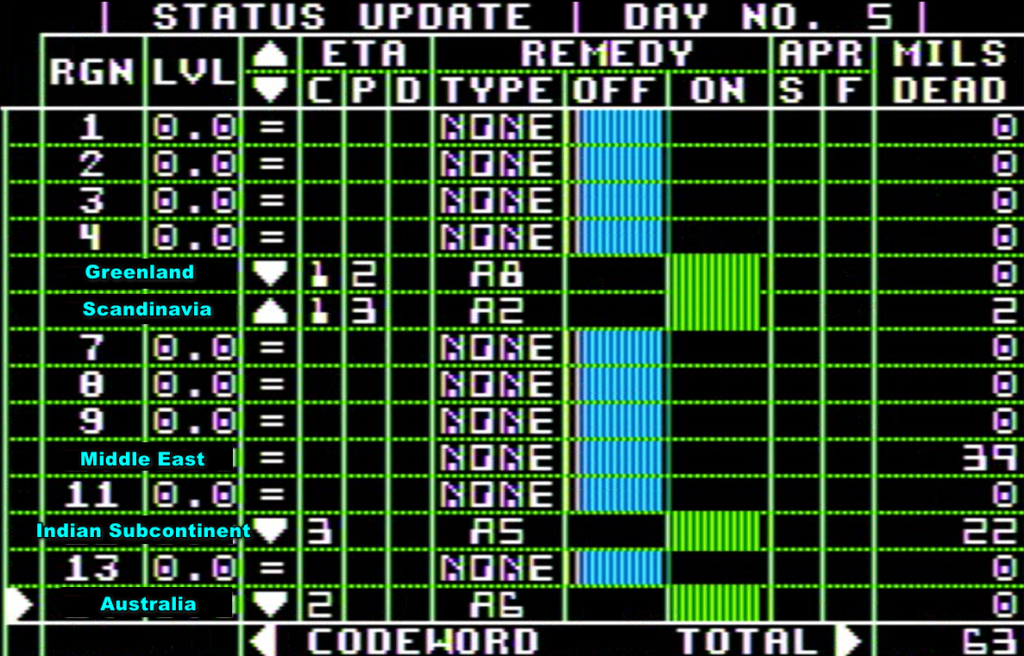
Nonetheless, the situation is under control. The only things left to do are sending missiles towards space or curing the “in-stasis” regions.
I have a chance to finish the game early rather than wait 25 turns. If I manage to remove all presence of the disease at the end of any turn, it is game over, meteorites or not. I start deploying more remedies, one region at a time, leaving two actions to shoot stuff towards the skies…
… sadly, I miss two missiles in a row, and viruses from space crash on Africa and on Australia:
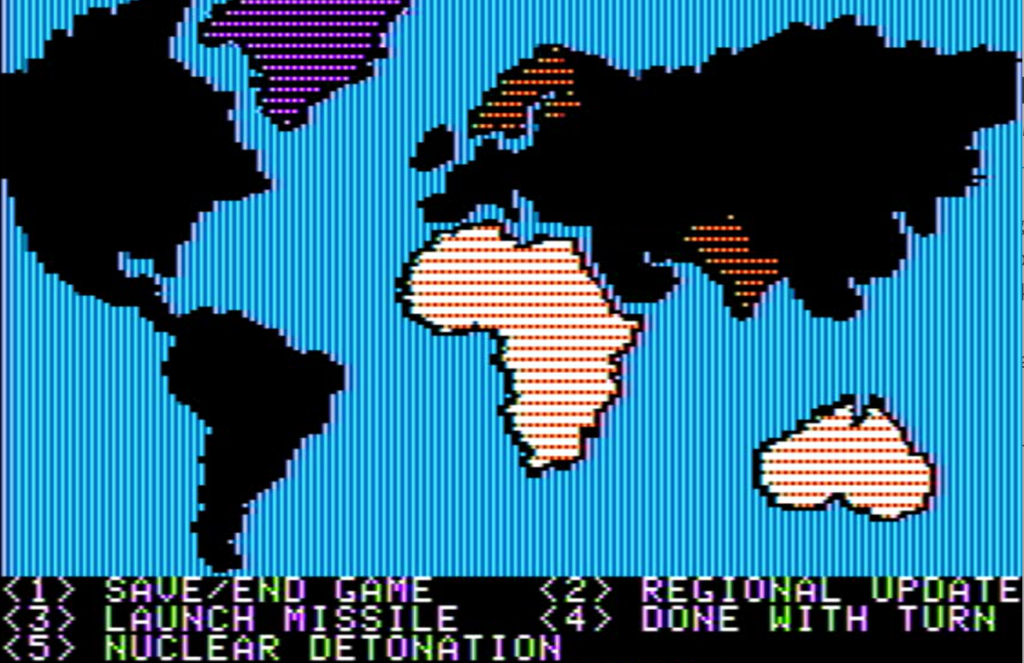
Still, nothing that Interferon cannot solve the following turn :
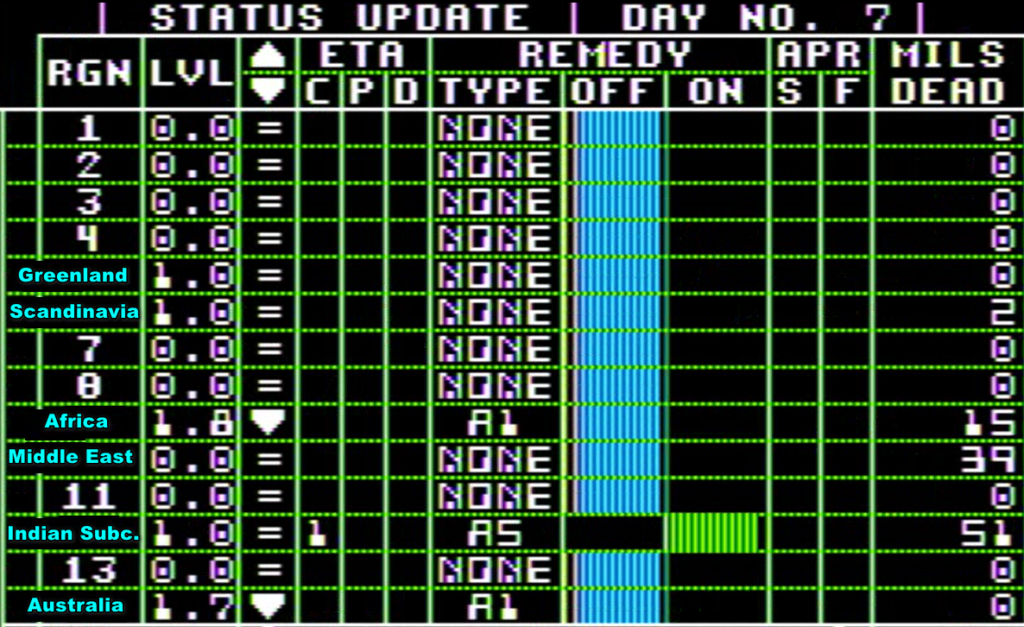
With no threat from space day 7, I can still maintain my target of disease eradication. Day 8 I manage to fully cure Africa and the Indian Subcontinent. With 3 continents, and 3 actions every turn, I cure the last diseased Scandinavians, Africans and Greenlanders day 9 :
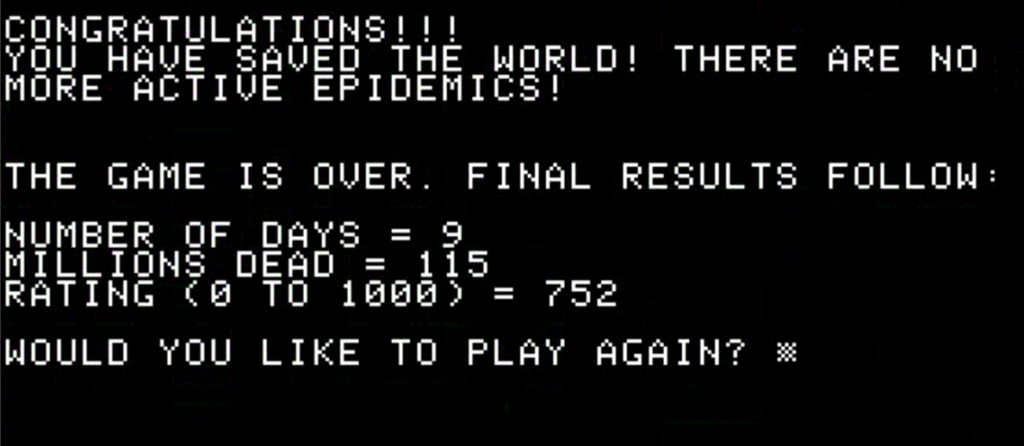
This was a short AAR, but in my experience either the disease is quickly contained and the game ends quickly, or the game passes a threshold where so many regions are contaminated that the player cannot cope with 3 actions. As I see it, I showcased almost all the features, except two that I will explain in the Rating & Reviews.
Rating and Review

Epidemic! by Steven Faber, published by SSI
First release : January 1983 on Apple II
Tested on : Apple emulator
Total time tested : 3 hours
Average duration of a campaign: 45 minutes (max difficulty, full game)
Complexity: Easy (1/5)
Would recommend to a modern player : No
Would recommend to a designer : No
Final Rating: Obsolete
I have sadly very little information about Epidemic! or Steven Faber, even Joel Billings draws a blank. Faber did not design any game after Epidemic! I found a Steven Faber as the author of Star Lanes, a multiplayer business simulation in 1977, and in 1978 as the author of a diabetes-monitoring program ; maybe the same person, maybe not. In any case, the length of an average session and the very high scope of the game made it fit perfectly the new RapidFire line of products. Another advantage Joel Billings remembers is that Epidemic! had been developed for Apple II but also for IBM PC, a market that SSI had not explored yet – Epidemic! would be the second IBM PC games of SSI, after a port of the Warp Factor in December 1982.
Initially released for Apple II and IBM PC and later ported on Atari in December 1983, Epidemic! was priced below any other SSI game at $34.95. Granted, the content of the box was underwhelming for SSI : only a manual and a reference card with the list of remedies on one side and the population by region on the other.
A. Immersion
Epidemic! clearly believes in gameplay first and realism second, and does not take itself to seriously, as I showed with the description of the “back fire” remedy.

As goofy as the manual is, it is hard to remain immersed in a game in which you can nuke whole regions or ignore virus-laden meteorites falling in Western Europe because the disease is “in stasis” there. Generally speaking, I would have preferred a game without the meteorites, but a more contagious disease.
Rating : Poor
B. UI , Clarity of rules and outcomes
The UI is helped by the fact that there are only 3 possible main commands in the game (remedy, missiles, nukes). Still, it has its frustrating aspects for such a simple game :
- You have to check the reference card to know the effect of remedies – possibly a very crude form of copy protection ?
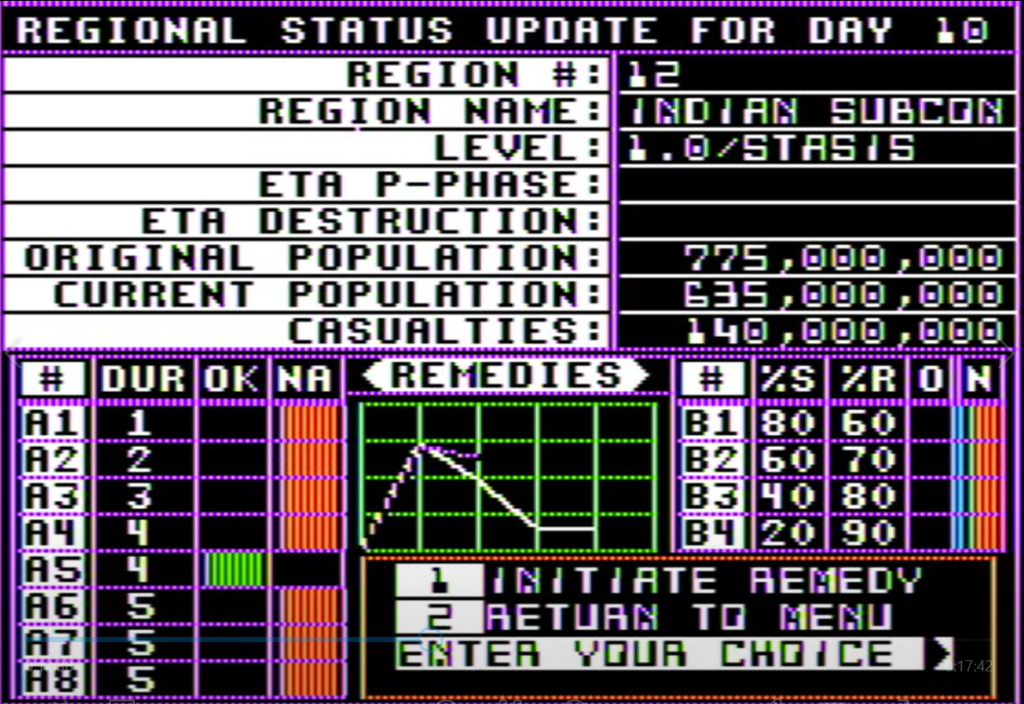
- When selecting targets for your missile, you need to try to compute the course of the meteorites yourself (all the elements are available). I think it would have been better with some estimation of where the meteorites will hit the Earth, even if not 100% accurate.
Rating : Adequate
C. Systems
I have covered all the existing features in the game except two :
- Pneumonia
After a certain number of turns at “mild” contamination level or above, or when the contamination level reaches 5.0, the contamination becomes pneumonic. In that situation, everyone in the region will die in 5 turns and normal remedies (called “type A”) won’t work. Instead, you need type B remedies, these are only active for one turn and have some odds of either lowering the disease level by a fixed percentage, or not at all. The objective is to bring the disease level below 1 before it kills everyone.

Those remedies have their own amusing descriptions :
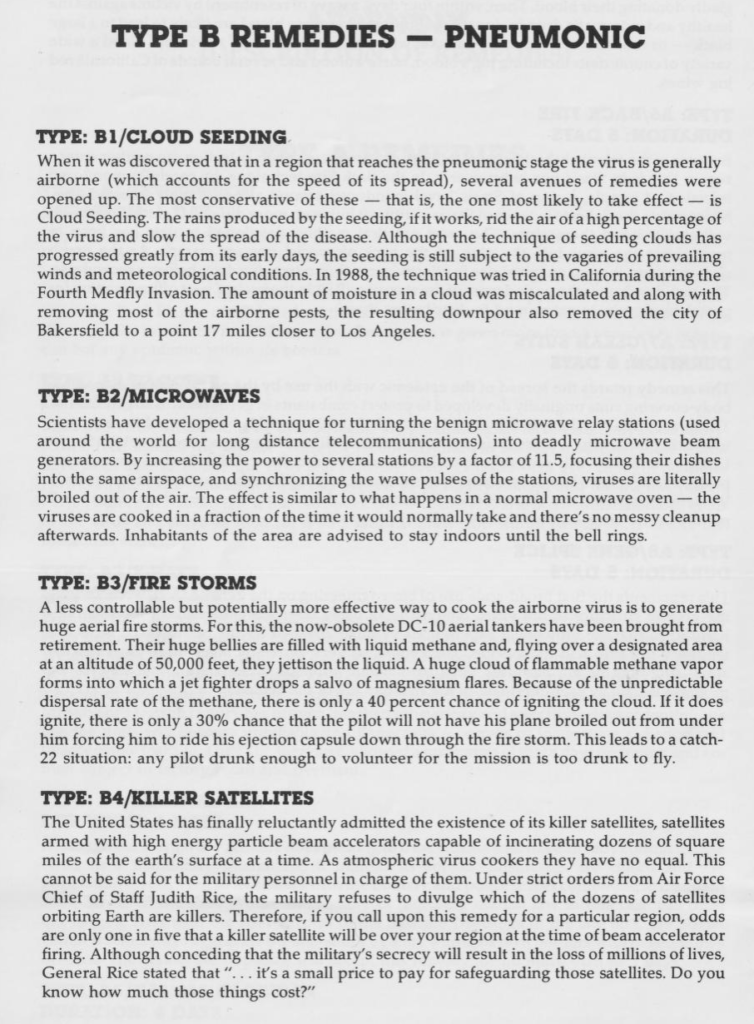
- Nuclear detonation
If the disease is festering in a region and you feel there is nothing you can do, you can quite simply blow up the whole region so it does not risk contaminating its neighbours. For that, you need to remember the turn-specific code word briefly showed to you at the beginning of the turn, and then use it.
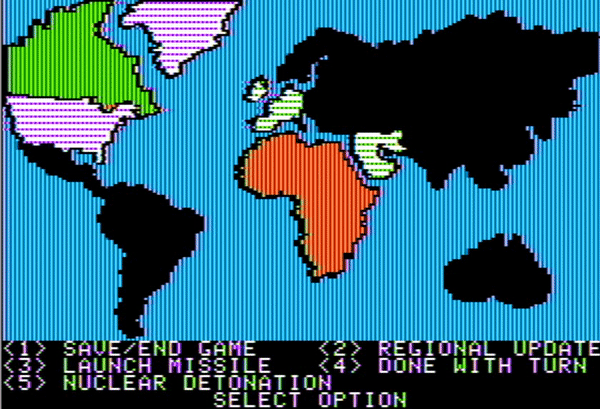
In practice, I believe there are very rare circumstances where it is necessary. If the region is strategic, you probably have acted early on with at minimum a long-term Gene Splicing. If the region is not strategic (typically Australia), why spend an action to accelerate its destruction ?
Overall, the game is all about prioritization :
- which regions to heal first (taking into account population, risk of spreading the disease further, and the fact that the health of USA/Soviet Union/Western Europe has an impact on the accuracy of the missiles – the only special rule of this kind),
- whether to heal them with the powerful A1 Interferon remedy, or heal them less with a long-term remedy in order to be able to spend some actions in other regions the following turns.
There is also some degree of strategic risk-management on whether to maintain a given region in “stasis”, or to try to heal it fully. I would have much preferred a stronger focus on policies, remedy inventory management, … As it stands, I feel that the game is both too simple and too random to be fun after a few sessions.
Rating : Poor
D. Scenario design & Balancing
The game has 4 levels of difficulty. At the lowest level of difficulty, the player has only 2 actions every turn, but there are also only 2 meteorites at the same time, and these approach Earth very slowly (it takes them between 2 and 4 days before impact). At this difficulty, the game is trivial.
Each level of difficulty after this increases the speed and the number of meteorites, the starting level of the disease when a meteorite hits a region, and the speed at which the disease spreads from region to region. The two higher levels of difficulty generously give the player one more action every turn.
At maximum difficulty level, the game significantly changes. In general, 3 or 4 meteorites crash on Earth at the same turn they appear, so proactively intercepting them is almost impossible. Moreover, a region hit by a meteorite can immediately start spreading disease to other neighbouring regions
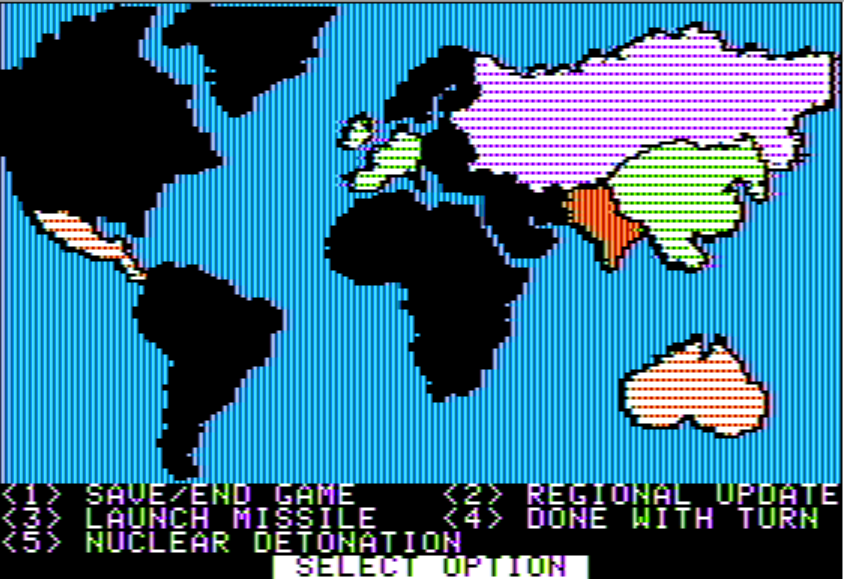
At maximum difficulty, it is impossible to cure the whole planet, the player’s goal is to put all regions at “stasis” level. It is not as easy as it sounds given you will have to use long term remedies that can overshoot and fully heal a region you wanted in stasis. Happily enough, the final score takes into account the difficulty of the game :
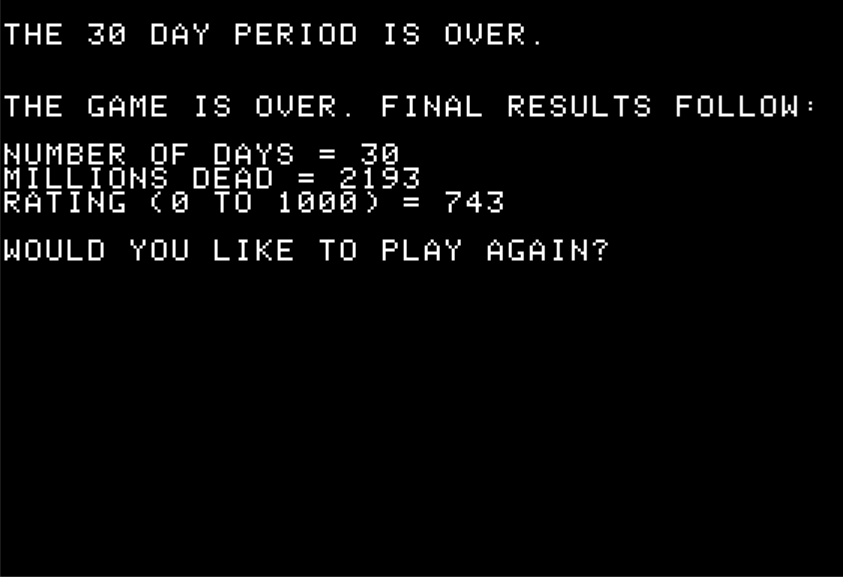
I regret the game is not offering more options, there is a real gap in gameplay between the third level of difficulty (used in my AAR, generally speaking too easy) and the last one (a bloodbath).
Rating : Poor
E. Did I make interesting decisions ?
Yes, though these were mostly “tactical”. There is no resource to manage, and due to the randomness of the meteorites’ impacts it is hard to maintain a strong containment policy, therefore the only real strategic decision is whether to try to cure the whole planet (and risk reinfection) or maintain a large part of it in stasis to only protect the high-population regions. I expected more.
F. Final rating
Obsolete. Epidemics! was fun at the beginning, but it quickly became repetitive.
Contemporary Reviews
Epidemic! only collected positive reviews, though rarely enthusiastic ones. Dale Archibald for Softalk (March 1983) may have pirated his version, as he complains that the game does not clearly tell you what the various cures do, when the reference card is very clear about it. Nonetheless, he calls Epidemic! an “absorbing game.” This point of view is echoed by Brian J. Murphy’s review in Creative Computing (September 1983) who calls the game “smooth” and the graphics “colorful and well-designed”, and concludes : “who ever thought the end of the world could be so fun !“
As expected, the most complete review comes from Computer Gaming World (March 1983). The review is introduced by a short AAR by the one-time reviewer Valerie Trott, in which she claims to have lost in 9 days in the easiest difficulty settings – I don’t really believe her but it makes for a good story. In any case, her only criticism is on the tediousness of the meteorite phase, but apart from that, it is “a good beginning level strategy game with excellent graphics [that] provides a real challenge. […] It is easy to learn and highly addictive”
Epidemic! is another early game that managed to be reviewed in France, once again by Casus Belli. For once, the review is quite generous : the graphics are certainly “poor” but the problem “vanishes” because the game is strategic anyway, and generally the game “keeps your attention“.
Epidemic! sold a bit less than 5 000 copies : 2 134 on Apple II, 1 924 on IBM PC (a disappointing performance) and 912 on Atari. Soon, we will be back to good old wargames where you send missiles and (rarely) nukes at real military targets.
I would like to thank Paul Hagström for uploading the manual of Epidemic! on archive.org. Without the remedy reference card, the game would not really be playable.
One Comment
This is maybe related to the basic game Swarms.
https://www.atariarchives.org/bcc3/showpage.php?page=261